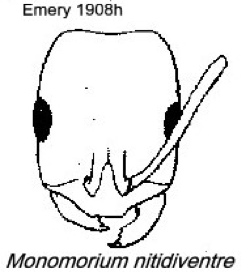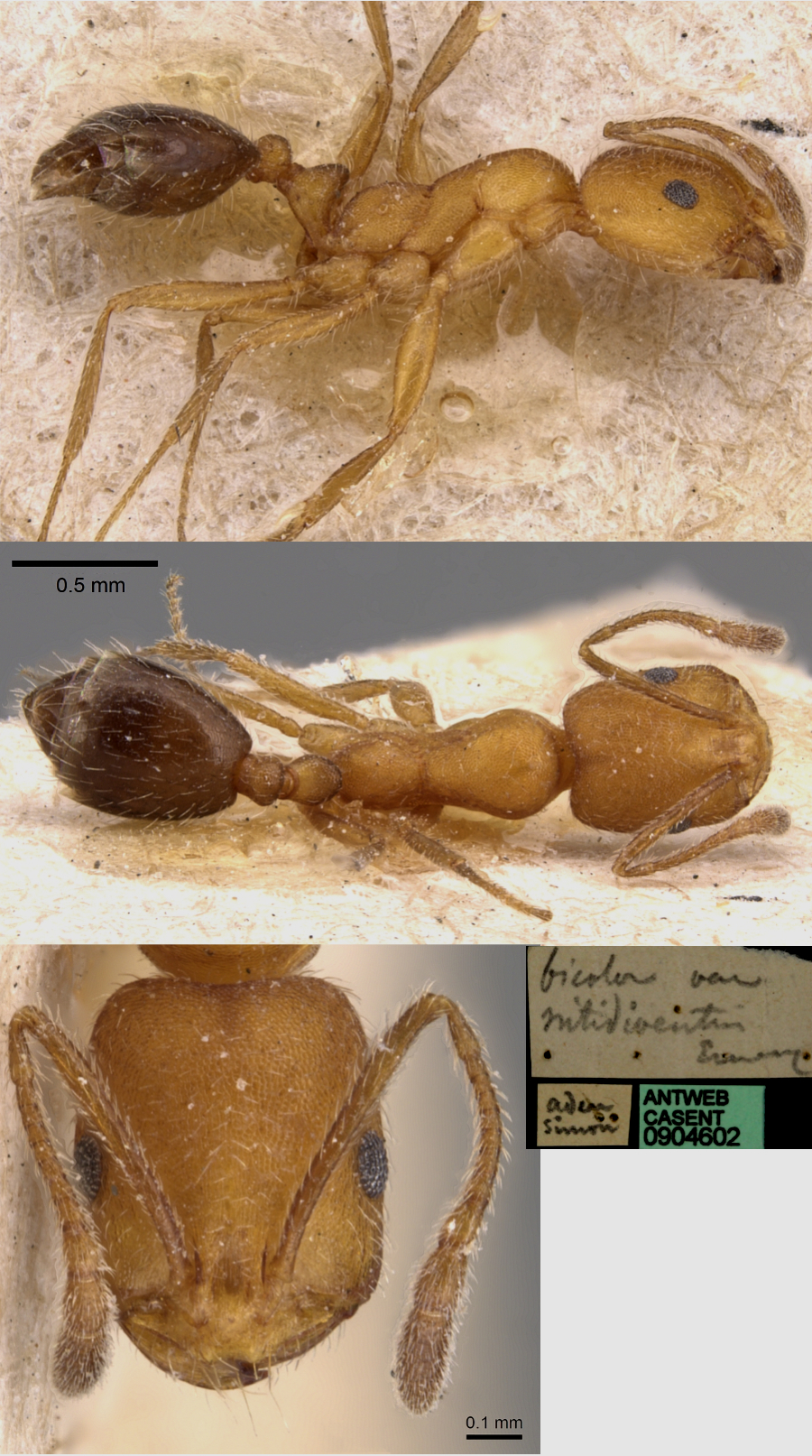Monomorium nitidiventre Emery
  Type location Yemen
(Emery, 1893f: 256, worker; Mayr, 1901b: 7, queen; Karavaiev, 1911: 5,
male; raised to species Collingwood, 1985: 272); type location wrongly
given in Bolton (1995: 265) as Egypt; see below Type location Yemen
(Emery, 1893f: 256, worker; Mayr, 1901b: 7, queen; Karavaiev, 1911: 5,
male; raised to species Collingwood, 1985: 272); type location wrongly
given in Bolton (1995: 265) as Egypt; see below
new junior synonym
- judaicum (Menozzi, 1933b: 63, illustrated, worker) from Israel
(transferred from subspecies of bicolor) - no images on Antweb
(February 2015).  . .
|
Bolton (1987: 331) dealing with the bicolor-complex
described nitidiventre as a sibling species from around the
eastern end of the Mediterranean and did not include it among the
Afrotropical species. He does not appear to have any reference to the
Santschi (1914b: 73) report of nitidiventre from Naivasha, Kenya,
collected by Alluaud & Jeannel, and neither of the papers by
Karavaiev (1911) and Viehmeyer (1923), reporting Sudan
findings, are among his references.
|
 Emery (1893f) simply
noted, specimens from Aden [Yemen],
collected by E Simon, - "differs from type (bicolor) by its
smaller size, TL 2.6-2.8 mm; by its clear colour, which is more orange
where the type is red and by the shiny gaster. Received also from
Cairo". Emery (1908h: 677) had an illustrated note at Emery (1893f) simply
noted, specimens from Aden [Yemen],
collected by E Simon, - "differs from type (bicolor) by its
smaller size, TL 2.6-2.8 mm; by its clear colour, which is more orange
where the type is red and by the shiny gaster. Received also from
Cairo". Emery (1908h: 677) had an illustrated note at  . Karavaiev (1911) had . Karavaiev (1911) had  and and  . Viehmeyer (1923) had . Viehmeyer (1923) had  .
Menozzi's (1933b) illustrated description of judaicum is at .
Menozzi's (1933b) illustrated description of judaicum is at 
Collingwood (1985: 272) noted "This small bicoloured
species ... differs from M. bicolor
in the shorter head and
appendages, the scape does not reach the occipital border - and by the
presence of more numerous long dorsal hairs all over the alitrunk". The
hairs on the dorsal alitrunk are clearly visible on the type worker
(below). In defining Monomorium jizane, Collingwood & Agosti (1996) separated it as having hairs on the alitrunk whereas M. nitidiventre has not. The question remains as to whether or not M. jizane is a separate species.
|
 The photomontage of a
type collection worker from Yemen is collated from http://www.antweb.org/specimen.do?name=casent0904602 The photomontage of a
type collection worker from Yemen is collated from http://www.antweb.org/specimen.do?name=casent0904602
|
 The photomontage is of a
specimen from Iran, Fars Province,
collector Omid Paknia. It clearly shows the bluish sheen to the
gaster and has the smaller size, etc., described for nitidiventre. The photomontage is of a
specimen from Iran, Fars Province,
collector Omid Paknia. It clearly shows the bluish sheen to the
gaster and has the smaller size, etc., described for nitidiventre.
|
|